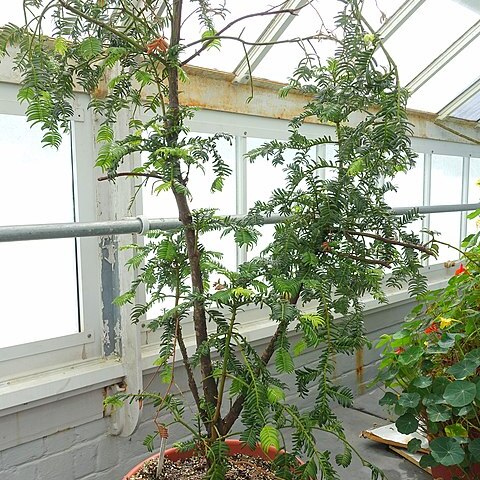Shrubs or small trees to 4 m tall; bark yellow to grayish brown, scaly. Leafy branchlets oblong-elliptic in outline, plane, 7-9 × 3.5-5 cm. Leaves borne at 55-70° to branchlet axis; petiole ca. 0.5 mm; blade dull matt green adaxially, linear-lanceolate, ± straight or very slightly falcate, strongly convex, (1.5-) 1.6-2.5(-3.2) cm × 2.3-3.2 mm, hard and leathery, midvein ca. 0.8-1 mm wide, stomatal bands on abaxial surface 0.8-1 mm wide abaxially, of 13-17 rows of stomata, as wide as (rarely wider than) midvein and marginal bands, marginal bands ca. 0.8 mm wide, base shallowly cordate or cordate-truncate, margin flat, apex obtuse, shortly cuspidate, cusp often breaking off. Pollen-cone capitula axillary, borne on lower side and toward distal end of terminal branchlets; buds developing before the subtending leaves expand; microsporophylls 6-10, each with 3 or 4 pollen sacs. Seeds cones solitary; peduncle ca. 6 mm. Seed obovoid, ovoid, or almost globose, 2.2-2.7 × 1.4-1.8 cm, apex with small mucro. Pollination Mar-Apr, seed maturity Aug-Oct. 2n = 24*.
More
A shrub or small tree. It grows 4-10 m tall. The trunk can be 20 cm across. The branches are opposite or in rings. The leaves are in 2 rows. They are narrow and hard and 2-4 cm long by 3-4 mm wide. The male cones are in groups of 5-7 clustered in a head 6-7 mm across. The fruit is oval and occurs singly. They are 3-4 cm long and 1-1.5 cm wide.
An understorey shrub in evergreen, broad-leaved forests; at elevations from 300-2,300 metres. Coniferous and broad-leaved forests; at elevations from 300-1,800 metres.
More
It is a subtropical plant. It grows in conifer forests and broad-leaved forests between 300-1,800 m.


